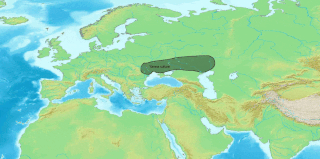This article includes a list of general references, but it lacks sufficient corresponding inline citations .(April 2009) |
This list contains purported Lusitanian deities, that is the gods and goddesses of Lusitanian mythology.
This article includes a list of general references, but it lacks sufficient corresponding inline citations .(April 2009) |
This list contains purported Lusitanian deities, that is the gods and goddesses of Lusitanian mythology.
Bibliography
References
Lusitanian mythology is the mythology of the Lusitanians, an Indo-European speaking people of western Iberia, in what was then known as Lusitania. In present times, the territory comprises the central part of Portugal and small parts of Extremadura and Salamanca.
The Lusitanians were a people living in the far west of the Iberian Peninsula, corresponding roughly to Central Portugal and some areas of modern-day Extremadura and Castilla y Leon, in Spain. After its conquest by the Roman Republic the land was subsequently incorporated as a Roman province named after them (Lusitania).

Ataegina was a goddess worshipped by the ancient Iberians, Lusitanians, and Celtiberians of the Iberian Peninsula. She is believed to have ruled the underworld.

Nabia was a goddess of the Pre-Roman peoples of the Iberian Peninsula, although she also had an extended cult during the Roman occupation of the peninsula.

Tongoenabiagus was the god of the Fonte do Ídolo, a 1st-century shrine in Braga with an inscribed fountain dedicated both to Tongoenabiagus and the goddess Nabia. His name may derive from the Celtic root *tenge(o)- and so he may have been associated with the swearing of oaths.
Trebaruna, also Treborunnis and possibly *Trebarunu, was a Lusitanian deity, probably a goddess. Trebaruna's cult was located in the cultural area of Gallaecia and Lusitania.

Celtiberian or Northeastern Hispano-Celtic is an extinct Indo-European language of the Celtic branch spoken by the Celtiberians in an area of the Iberian Peninsula between the headwaters of the Douro, Tagus, Júcar and Turia rivers and the Ebro river. This language is directly attested in nearly 200 inscriptions dated from the 2nd century BC to the 1st century AD, mainly in Celtiberian script, a direct adaptation of the northeastern Iberian script, but also in the Latin alphabet. The longest extant Celtiberian inscriptions are those on three Botorrita plaques, bronze plaques from Botorrita near Zaragoza, dating to the early 1st century BC, labeled Botorrita I, III and IV.

Lusitanian was an Indo-European Paleohispanic language. There has been support for either a connection with the ancient Italic languages or Celtic languages. It is known from only six sizeable inscriptions, dated from c. 1 CE, and numerous names of places (toponyms) and of gods (theonyms). The language was spoken in the territory inhabited by Lusitanian tribes, from the Douro to the Tagus rivers, territory that today falls in central Portugal and western Spain.
The Quaquerni or Querquerni were an ancient tribe of Gallaecia, living in the Baixa Limia region of southern Galicia, where the Roman fort of Aquis Querquennis has been found.

Hispano-Celtic is a term for all forms of Celtic spoken in the Iberian Peninsula before the arrival of the Romans. In particular, it includes:

Galicians are a European ethnic group from northwestern Spain; it is closely related to the northern Portuguese people and has its historic homeland in Galicia, in the north-west of the Iberian Peninsula. Two Romance languages are widely spoken and official in Galicia: the native Galician and Spanish.

The Fountain of the Idol is a Roman fountain located in the civil parish of São José de São Lázaro, in the municipality of Braga, northern Portugal. Located in the former territory of the Callaici Bracari, the granite rock fountain/spring has Latin inscriptions, dedicated to the Gallaecian and Lusitanian gods Tongoenabiagus and Nabia.
Bandua was a theonym used to refer to a god or goddess worshipped in Iberia by Gallaeci and Lusitanians. Whether the name referred to a discrete deity or was an epithet applied to different deities is arguable.
Reo is a name appearing on Latin dedications to a Lusitanian-Gallaecian deity, usually with an epithet relating to a place, such as Reo Paramaeco discovered in Lugo in Galicia. The name Reo is in the Latin dative case, for a Latinized name *Reus.
Gallaecian or Northwestern Hispano-Celtic is an extinct Celtic language of the Hispano-Celtic group. It was spoken by the Gallaeci in the northwest of the Iberian Peninsula around the start of the 1st millennium. The region became the Roman province of Gallaecia, which is now divided between the Spanish regions of Galicia, western Asturias, the west of the Province of León, and the North Region in Portugal.

María de Echarri y Martínez was a Spanish catholic propagandist and columnist, advocate of feminist causes.
Julio Gil Pecharromán is a Spanish historian, specialising in the political history of 20th-century Spain.

Ángel Bahamonde Magro is a Spanish historian. He is professor of Contemporary History at the Charles III University of Madrid (UC3M).

The Campo de San Juan was the seigneurial lordship of the Order of St. John in the lands of La Mancha. It was the most important possession of the Grand Priory of the langue of Castile and León. It spanned across territory of the current Spanish provinces of Toledo and Ciudad Real. The most important urban centres were Consuegra and Alcázar de San Juan.
Arentius and Arentia are considered to be a pair of indigenous deities that belong to the Lusitanian pantheon, and attested mainly in epigraphy.